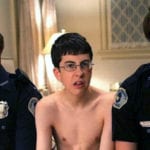 Weird Stuff
Weird Stuff  Weird Stuff
Weird Stuff  Mysteries
Mysteries 10 Tragic Disappearances and Deaths in Joshua Tree National Park
 History
History 10 Ways Childhood Really Sucked in the Old West
 Music
Music 10 Name Origins of Famous Bands from the 1990s
 Religion
Religion 10 Biggest Turnarounds by the Catholic Church
 Weird Stuff
Weird Stuff 10 Unbelievable Times Laws Had Unintended Consequences
 Humans
Humans Ten Historic Women Who Deserve Way More Credit Than They Got
 Movies and TV
Movies and TV 10 Films That Spawned Major Lawsuits
 History
History Ten Times Towns Were Wiped Off the Face of the Earth
 Creepy
Creepy 10 of the Most Disturbingly Haunted Public Houses in the UK
 Weird Stuff
Weird Stuff 10 Niche Subcultures That Are More Popular Than You Might Think
 Mysteries
Mysteries 10 Tragic Disappearances and Deaths in Joshua Tree National Park
 History
History 10 Ways Childhood Really Sucked in the Old West
Who's Behind Listverse?

Jamie Frater
Head Editor
Jamie founded Listverse due to an insatiable desire to share fascinating, obscure, and bizarre facts. He has been a guest speaker on numerous national radio and television stations and is a five time published author.
More About Us Music
Music 10 Name Origins of Famous Bands from the 1990s
 Religion
Religion 10 Biggest Turnarounds by the Catholic Church
 Weird Stuff
Weird Stuff 10 Unbelievable Times Laws Had Unintended Consequences
 Humans
Humans Ten Historic Women Who Deserve Way More Credit Than They Got
 Movies and TV
Movies and TV 10 Films That Spawned Major Lawsuits
 History
History Ten Times Towns Were Wiped Off the Face of the Earth
 Creepy
Creepy 10 of the Most Disturbingly Haunted Public Houses in the UK
Top 15 Miniseries of all Time
Miniseries (called “serials” in Great Britain) are limited-run TV shows, that generally last three to six episodes. The miniseries used to be one of the highlights of network television. A novel, usually historical, was recreated as a massive, made-for-TV movie, played out over successive nights. In their heyday, they were massive ratings winners. These days, the miniseries is all but dead, and most things billed as miniseries today are laughably bad two-night affairs, but with some rare and terrific exceptions. What follows are some of the most notable and successful ones. (And some are not necessarily my favorites, either.) Please note that shows such as Victory at Sea and The World at War are not included, as they are classified as regular series or documentaries, not miniseries or serials.
HBO proved that a high-quality historical miniseries could still be made—and watched—in the late 2000s. Starring Paul Giamatti in the title role, and loosely based on James McCullough’s award-winning biography, John Adams tells the story of the Patriot, from the Boston massacre of 1770 to Adams’ death in 1826. John Adams won 13 Emmys and 4 Golden Globes, and earned very favorable audiences.
Gulliver’s Travels, based on the Jonathon Swift novel, starred real-life husband and wife Ted Danson and Mary Steenburgen as Dr. Gulliver and his long-suffering wife. After a years-long absence abroad, Gulliver returns home full of fantastic tales of small people, giants, talking horses, etc., and is promptly thrown in an insane asylum. Very well done and well received by English and American audiences and critics. (This is the only two-episode mini-series on the list.)
I haven’t seen this, but would definitely like to. This three-part Soviet Union miniseries took the familiar Alexander Dumas story of the Three Musketeers, and Musketeer wannabe d’Artagnan, and turned it into a pop musical—while sticking quite faithfully to the original novel. D’artagnan and Three Musketeers was wildly popular in the ol’ evil empire in the 1970s and 1980s, and spawned a few sequels.
You might be surprised at this entry, but this popular 25-chapter miniseries, produced for the Cartoon Network in the early 2000s, is actually quite good—and a two-time Emmy winner and Saturn-award nominee. Cartoon whiz Genndy Tartakovsky (“Samurai Jack” and “Dexter’s Laboratory”) created Clone Wars to bridge the gap between Episodes II and III, and did so rather admirably. Though it’s quite obvious that you’re watching a cartoon (the art is the same as the two aforementioned cartoons), the action is intense and satisfying, and the bits of character development are quite nice. Chapters 1-20 are each only a few minutes long, while chapters 21-25 are 13-15 minutes each. And if you ever wondered why General Grievous has a wheeze and hacking cough throughout Revenge of the Sith, you have to see the final episode of Clone Wars. Hint: Mace Windu is every bit the BAMF here as Samuel L. Jackson should have been allowed to be in the three prequel movies. The clip is a promo for the rebroadcast of the first episodes on the network’s great, late and sorely missed Toonami show.
Aliens, identifying themselves as “The Visitors”, arrive offering to help Earth with diseases, and other crises, in exchange for common Earth chemicals that their people desperately need. Except (of course!) the aliens hide terrible secrets—and their true physical appearances—and it’s up to an intrepid reporter (Marc Singer) and scientist (Faye Grant) to expose the truth. Actually, it’s not as run-of-the-mill hokey as it sounds. It’s a rather heavy-handed allegory of fascist takeover with silenced critics, isolation and demonization of potential opponents, media control, a youth organization akin to the Hitler Youth, etc. The miniseries ends with the resistance movement’s first victory, and picks up some three months later in the sequel, “V: The Final Battle” (1984). The sequel is one of the few places where you’ll see the great character actor Michael Ironside play a good guy. Though the original miniseries and sequel were quite popular, the regular TV series spinoff fizzled quickly in its only season. The clip is a recap of part 1.
This 1976 BBC production was quite successful, and memorable, for its vast cast. It told the tale of the first Caesars through the eyes of the fourth one, Claudius, who was considered (to put it kindly) retarded. Note: “I, Claudius” is not to be confused with the notorious pornographic movie, “Caligula.” The clip is a scene between Claudius and the terrific villain, Livia, over Claudius’ desire to do a public reading of his book.
Set on the Australian outback, The Thorn Birds follows the saga of the Clearys for roughly 40 years, starting in the 1920s. The miniseries concentrates on young Meggie Cleary and her eventually illicit relationship with banished Catholic priest Father Ralph de Bricassart (Richard Chamberlain). The Thorn Birds was quite controversial for showing that relationship—especially the sex scene—and for broadcasting the miniseries during Holy Week, prompting a predictable protest from Catholic quarters. Either despite or because of the controversy, The Thorn Birds was a ratings smash.
This South African Broadcasting Corporation miniseries portrayed the life of Shaka Zulu, who was king of the Zulu nation between 1818 and 1828, and ruled a large empire. Stark in its portrayal of violence and non-gratuitous nudity, Shaka Zulu still stands up well today. It’s fascinating that the United Nations almost blacklisted the British actors who worked on the production—apartheid was still very much in force in South Africa—despite the fact that the production showcased the powerful title character sympathetically, and the historical Brits and Dutch didn’t come off that well. Interesting note: Shaka Zulu showed frank upper and backside nudity, and when I first saw it in 1986, I couldn’t help but wonder if a little “National Geographic” was at work there – meaning, it was OK to show black women’s breasts, but not white women’s breasts. I really don’t know. The clip shows young Shaka (Henry Cele) in a gorgeously filmed and scored scene reminiscent of the first Rocky movie.
Shogun, based on a novel by James Clavell, tells the story of Englishman John Blackthorne (Richard Chamberlain) who becomes assimilated in 1600s Japan after he is shipwrecked. Shogun wowed audiences and critics alike, and sparked a wave of historical-based miniseries in the 1980s. Shogun was filmed entirely in Japan and broke many TV taboos, such as urination, frank talk of sex, graphic violence (a beheading) and torture. Most of the Japanese actors didn’t speak any English, either. Fun fact: During the September 1980 broadcast, restaurants and movie theaters actually reported a drop in attendance, supposedly because people were home watching Shogun. And you just gotta love the cheesy 1980 NBC promo intro in the clip above.
Based on the Pulitzer Prize-winning Larry McMurtry novel, Lonesome Dove was one of the most popular miniseries of them all, spawning several sequels and a decent TV series spinoff. Robert Duvall and Tommy Lee Jones play the main protagonists, Gus McCrea and Woodrow Call, ex-Texas Rangers who lead a cattle drive from Lonesome Dove, Texas, to Montana. Fun fact: McMurtry originally wrote Lonesome Dove in 1971 as a movie script for John Wayne. When Wayne demurred, McMurtry later rewrote the script as a novel.
John Jakes’ American Civil War trilogy of the iron-making Hazzards of Pennsylvania, and the slave-owning Mains of South Carolina, became three of the monster best-selling historical novels of the latter 20th century. Naturally, the first book was made into a miniseries (an “ABC Novel for Television”) in 1985 with a typical all-star cast, starring Patrick Swayze, James Read, Kirstie Ally, David Carradine, Ryan Mitchell (one of Hollywood’s greatest character actors), Genie Francis, Olivia de Havilland, Gene Kelly, etc. North and South and its follow-up, North and South Book II (1986, based on Jakes’ sequel, Love and War) were gigantic ratings and critical successes, though the first is superior. The third installment, made in 1994, bombed badly, mainly because of lousy writing, significant plot and cast changes, and the fact that almost 10 years had passed since the novels and first two miniseries came out. The clip is the series’ first promo.
In the introduction to his novel The Winds of War, Herman Wouk says that the book (and its sequel) was written not for those who experienced the war, but for those who didn’t. The Winds of War tells the tale of the far-flung Henrys, an American naval family, between the summer of 1939 and just after the attack on Pearl Harbor. Starring Robert Mitchum as patriarch Pug Henry, The Winds of War was a ratings beast. The sequel, War and Remembrance (1989), itself was a monster in more ways than one: it was split into two miniseries that ran six months apart and seemed to have a kitchen-sink approach. If the producers could fit in a scene, they did. War and Remembrance featured a stark, no-holds-barred representation of the Nazi massacre of Jews at Babi Yar. The Winds of War was more successful than War and Remembrance, partly because in the former, it’s believable when Robert Mitchum’s Pug Henry flirts with the much younger Pam Tudsbury, but it became painfully embarrassing six years later in War and Remembrance when Mitchum’s age was blatantly obvious. (He even complains, “Pam, I’m too old for you!”) Still, The Winds of War saga stands as a landmark in TV entertainment – and serves as a reminder to we brash Americans that we didn’t win the war all by our lonesome John Wayne selves. The clip is an overly-dramatic promo for War and Remembrance.
It was difficult putting this incredible awesome HBO miniseries in third place, but the number 1 and 2 choices have had a wider and longer-lasting impact. Anyway, this joint Steven Spielberg-Tom Hanks production tells the real-life story of Easy Company (E Company, 2nd Battalion, 506th Parachute Infantry Regiment, 101st Airborne Division) from D-Day to the end of the war in Europe. While historical inaccuracies pepper the series, mostly out of TV necessity, the overall presentation is just superb. It’s better than Saving Private Ryan, and better than most any other war movie. The sequence where the company takes out an artillery battery is one of the greatest action segments ever filmed, in my opinion.
This joint English-Italian production is hailed as a masterpiece and in 1978 was labeled the greatest miniseries of all time by TV Guide. Franco Zeffirelli’s life of Jesus Christ was gorgeously filmed, powerfully acted and featured a haunting performance by Robert Powell as Jesus. (Yes, his unblinking steel-blue eyes throughout was a deliberate effect.) The notable cast included James Earl Jones, Christopher Plummer, Peter Ustinov, Stacy Keach, James Mason, Anthony Quinn, Michael York, etc. The music was appropriately powerful and the setting fitting for the times. Michael York’s performance as John the Baptist is exemplary, and exactly how you’d imagine that the locust-eating John was. If you watch only one movie or miniseries about Jesus Christ, make it this one. The clip shows part of the Sermon on the Mount, showcasing the miniseries’ powerful music.
The most-watched miniseries of all time and one of the most-watched shows of any type, Roots is the serialized version of Alex Haley’s personal account of his ancestry. Beginning with Kunta Kinte’s (Levar Burton) capture by slave traders in 1750, Roots follows the life of Toby (as Kunta Kinte was forcibly renamed) through his escape attempts and adulthood, and carries the tale of his children and grandchildren past the Civil War. Fun fact: Georg Stanford Brown, who played Toby’s free great-grandson who fights in the Civil War, also played the escaped slave Grady in North and South, where he is recruited by John Brown.
Notable omissions include: Battlestar Galactica (2003), Centennial, The Stand, The Jacksons: An American Dream and Angels in America, which could be numbers 16-20, respectively.








